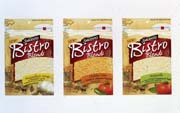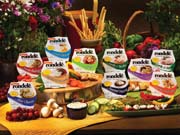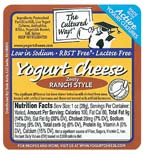Sustaining that healthy growth takes innovation into new ways of making high-quality cheese. Ongoing flavor and functionality research sponsored by Dairy Management Inc.™ (DMI) is aimed at giving cheese manufacturers countless ways to satisfy the nation's love of cheese.
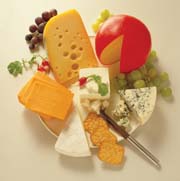
Photo courtesy of Danisco
Flavorful Cheese
Researchers at several universities are focused on enhancing cheese flavor. For example, research at the DMI-sponsored Southeast Dairy Foods Research Center at North Carolina State University is currently determining if there are any regional differences in aged Cheddar cheese flavor. According to dairy sensory expert MaryAnne Drake, "There are ‘perceived' regional differences in Cheddar cheese flavor. A good example of this perception is the labeling of certain Cheddars as ‘New York' or ‘Vermont-style.' "Her team is currently investigating flavor and texture differences of aged Cheddar cheese produced in different U.S. states and regions (California, the Northwest, the Midwest and the Northeast). "Knowledge of the actual regional differences in Cheddar cheese and the nature and source of these differences would enhance the ability to identify methods to alter or accelerate cheese flavor development where needed or desired," says Drake.
Researchers at the Wisconsin Dairy Research Center at the University of Wisconsin-Madison and the Western Dairy Center at Utah State University in Logan, Utah, have completed a draft genome sequence of Lactobacillus helveticus CNRZ32, a starter culture that can be used to produce ripened cheeses with reduced bitter off-flavors. Using the sequence, researchers can better understand the role of endopeptidases in L. helveticus CNRZ32.
"These enzymes reduce the accumulation of bitter peptides and hence the development of bitterness in ripening cheeses," says Jim Steele, a researcher at the University of Wisconsin. The genome sequence will also be used to construct or isolate cultures that result in intensely nutty or sweet cheeses, which can be used as either table cheese or as ingredients.
Additional genomic work at the DMI-sponsored Wisconsin and Western centers is exploring the construction of strains of Lactobacillus casei that over express a bacterial lipase known to enhance cheese flavor. Newly constructed strains could be used to produce fruity cheese. A second objective of this project is to manufacture processed cheese from Cheddar cheese having significantly elevated levels of free fatty acids or furanones and pyrazines. "The resulting cheeses would be used as ingredients in cheese sauces and in baking applications," Steele explains.
Steele is also working to construct Lactococcus lactis S2 derivatives with enhanced activity of peptidases. These strains could be used in industry to reduce the incidence of bitterness in bacterial ripened cheeses. "L. lactis is the starter culture used in the manufacture of Cheddar cheese and plays a significant role in almost all biochemical events related to cheese ripening. For example, the proteinase specificity of the starter culture is a major determinant in whether bitterness will develop," explains Steele.
At the Minnesota-South Dakota Dairy Foods Research Center at the University of Minnesota, Center Director Lloyd Metzger and coworkers are looking to limit Maillard reactions in retort products containing processed cheese. Maillard reactions can have a number of unfavorable consequences, including the formation of off-flavors. Metzger's work involves the elimination of lactose from the processed cheese formulations.
To do so, Metzger is developing processed cheese formulations that fit within the standard of identity of processed cheese foods, as well as formulations that do not fit within the standard of identity of processed cheese. For example, whey protein isolate and various other milk protein concentrates are essentially lactose free. Therefore, it is possible to use a combination of natural cheese, anhydrous milkfat, whey protein isolates and milk protein concentrates to produce a processed cheese that is essentially lactose free. Such a product would be resistant to Maillard browning and would create retorted cheese-based food products such as chili with chunks of cheese.
At Utah State University, work has resulted in the commercialization of a novel adjunct strain for cheese manufacture. Researchers investigated the role of metabolic cross-feeding between starter, adjunct and nonstarter cheese bacteria in the production or removal of aromatic off-flavor compounds that can pose a problem in manufacturing of low-fat Cheddar cheese. The study found that when added to cheese as an adjunct culture, Brevobacteria linens BL2 significantly improved cheese flavor and did not increase the aromatic off-flavors, as judged by both trained experts and consumer taste panels. "BL2 is now available as a cheese flavor adjunct for Cheddar cheese," says researcher Jeff Broadbent.

Enhancing cheese functionality
In low-fat mozzarella cheese, increasing its moisture content is one way to enhance its melting properties. Exopolysaccharide-producing starter cultures can be used to significantly increase the moisture content of lower-fat mozzarella cheese. Researchers at Utah State have identified the culture Streptococcus thermophilus MR-1C, which produces a large capsular exopolysaccharide. Researchers have shown that this capsule is involved in cheese moisture retention."Our work showed that encapsulated strains significantly increased cheese yield and moisture level without affecting whey viscosity and cheese functionality. Several culture companies are now producing exopolysaccharide strains to be used as novel strains in cheesemaking," says Broadbent. Experiments are now under way to characterize the structure of the MR-1C exopolysaccharide and isolate the genes that encode its biosynthesis. This will provide information needed to understand the influence of exopolysaccharide on cheese quality and functionality.
North Carolina State University researcher Christopher Daubert evaluated the effect of formulation and cooling rates on the functional properties of processed cheese. Results from his work will allow cheese manufacturers to manipulate cooling conditions to yield the highest quality product.
Daubert formulated a model system (rennet casein gels) by excluding milkfat and using protein and emulsifying salt concentrations similar to processed cheese. Rheological tests were performed on the model system without pH adjustment (pH 7.2). The model system showed a trend similar to processed cheese when cooled at various cooling rates. A slower cooling rate resulted in a stronger product. Daubert developed a mathematical model to describe the rheological data at different cooling rates, enabling prediction of how manufacturing conditions can influence cheese quality.
These innovations in cheese flavor and functionality will help maintain cheese's high standards of quality.
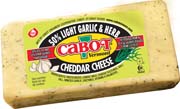
Sidebar:
Inspired by Vermont's summer gardens,Cabot Creamery Cooperative, Cabot, Vt., combines fragrant herbs and a touch of roasted garlic to its award-winning 50% Light Cheddar, creating new Cabot 50% Light Garlic & Herb Cheddar. Available nationally, the new variety is sold in random-weight deli bars and blocks. Cabot cheeses are also available online at www.shopcabot.com.
"The new FDA food pyramid guidelines recommend three servings of fat-free or low-fat dairy products a day," says Richard Stammer, pres. and CEO. "Our flavored light Cheddars, including the newest 50% Light Garlic & Herb, offer consumers options for reducing fat without compromising flavor or quality."
